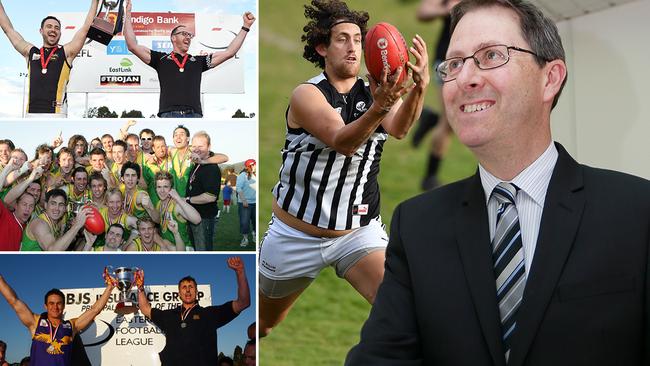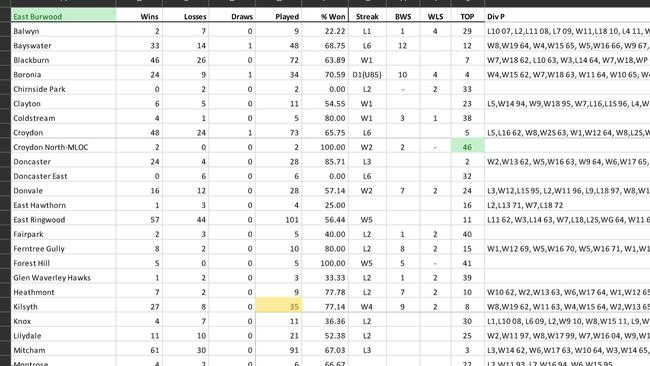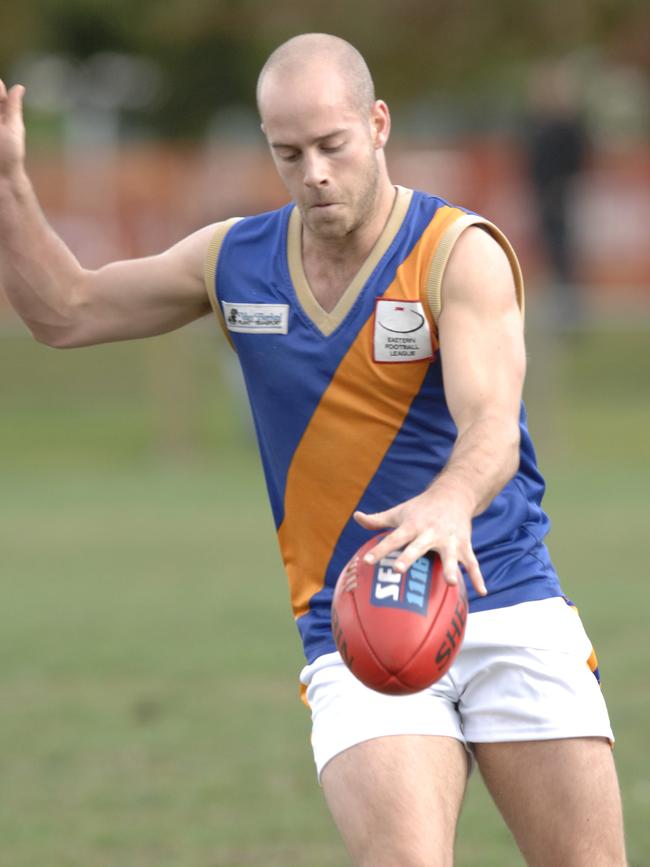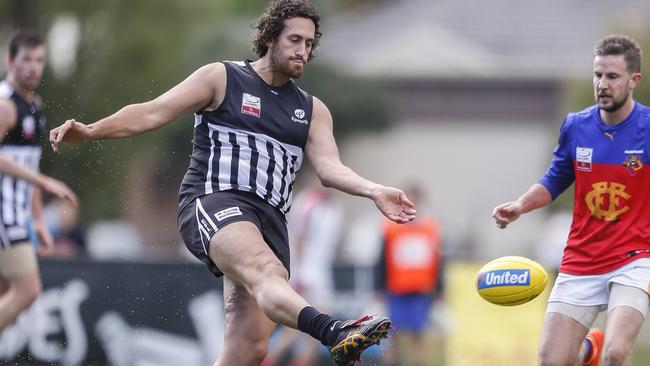How EFL data guru finds league’s quirkiest stats
Imagine your footy team being on top of the ladder going into the final round, only to miss the finals. This is one of the many quirks EFL stats guru Noel McPhee has uncovered as he takes us through his decades of number-crunching for the league.

Local Footy
Don't miss out on the headlines from Local Footy. Followed categories will be added to My News.
It is the first time since 1944 that there has been no football played in Melbourne’s east.
Some 76 years after the ‘44 season was called off due to WWII, and Eastern Football League followers across its now 46 senior clubs and 36 junior clubs have been thrust into an unfamiliar position – for many of their lifetimes, at least - of no sport due to the coronavirus crisis.
Like many of their local football-mad contemporaries across the state, this is a small price to pay given what’s at stake, what’s transpired and what may lie ahead.
But there’s no denying the impact grassroots football has on the lives of those involved, and the void it has left this season.
One of those rusted-on local football followers is EFL stats guru, Noel McPhee.
Week-in and week-out of a typical EFL season, Noel is madly adding to an ever-growing spreadsheet of statistics across the league’s wide array of senior clubs. Whether it be head-to-head, winning and losing streaks, winning percentages – you name it – Noel’s compiled it.
It wasn’t always a numbers game though for the league’s resident stats man.
A short stint for Mooroolbark’s reserves outfit came four years after he found his way into boundary umpiring in the early 1980s, officiating mainly first and second division matches and working his way around the grounds.

But a curiosity of Eastern league statistics around the turn of the century turned into a 20-year odyssey of gathering and collating stats of Australia’s largest local football competition.
“I think it was about 20 years (after umpiring) before I started, it must’ve been when the internet was relatively new and I was just playing around and I wondered if the EFL had a site,” he said.
In trawling through various sites, he stumbled across powerhouse club Vermont’s collection of club stats, compiled by late Eagles stalwart Jack Murphy – which continues to be maintained by club manager Lee Bidstrup.
“I thought ‘Gee, wouldn’t that be good to do one day for the whole league?’ – not realising what that meant,” McPhee said.
“I put it in the back of my mind, and it was sort of another seven or eight years later that I tried to start doing that.”
Noel details the labourious task of combing every Eastern league match since 1962 – when the competition was formed, then known as the Eastern Districts Football League, or EDFL.
Initial efforts of going to local libraries and sifting through old local newspapers such as the ‘Ringwood Mail’ seemed like a wild goose-chase, and bore next to no fruit.

But it was with the help of website localfootystats.com, updated and maintained by fellow local footy followers Marc McNay, along with significant groundwork by Matt Emslie, which saw the former umpire get to work on tallying and collating what was then about 45 years worth of information.
“It took probably three or four years (to collate every match),” he said.
“But little by little, I’d just do half an hour a night, and it did take a long time to put together.
“It got to the point where I’d gone through every match from ‘62 and it was probably four or five years ago when I’d finished all of that.
“I have to give the (localfootystats.com website) there a fair bit of credit.”
An email to then-EFL media manager Anthony Stanguts in the late 2000s canvassing the idea of a weekly stats column was met with approval, and so was born the 400-word ‘Statsbench’ yarn in the now-defunct football record, which became a staple for many EFL pundits.
After more than a decade active, Noel’s Statsbench column continues to engross readers online throughout the course of a typical season. It was also shortlisted for the award in the category of ‘best column’ at the AFL Victoria Media Awards two years in a row, across 2018-19.
But the architect behind an ever-expanding library of statistics has taken a well-earned breather in the lay-off this season. The only real stat to have emerged on the back of the COVID-19 crisis, is, well, just that – no football in the east since 1944.
He assures he keeps back-ups of the spreadsheet which houses the golden trove of information.

“Keeping it up-to-date I suppose (during a season) is the big thing, it probably takes me an hour a week just to put the 20-odd matches in,” McPhee said.
“I’ve got an excel spreadsheet of 60 individual sheets within that, of all the teams that have ever played.
“There’s 45 there at the moment, and there’s another 15 or so that have gone back to another league or disbanded.
“It’s quite a big spreadsheet … I’ve expanded it over the years to the point where I’ve wanted to break it down by division. It keeps evolving.”
While the masses remain hopeful of a return to the field next season, the long-standing EFL statistic Noel would love to see broken is Forest Hill’s 36-year premiership drought, which dates back to 1984 – the Zebras’ last flag.

Around 20 years after the initial thirst for knowledge however, what’s next for the EFL’s stats guru?
“The next stage is, I’ve started looking back further - what happened prior to the EFL? Can I get any more data on that? That’s another monumental, several-year task,” McPhee said.
“It’s always in the background.”
Old habits – and curiosities – die hard, and for Noel McPhee, who studied statistics at uni and previously worked at the Buearu of Statistics for 13 years, the passion for numbers continues today.
He plies his trade as a public servant these days, and manages 15 voting centres at election time in the Bellarine Peninsula, where he now resides.
Eventually he plans to hand his coveted encyclopedia of numbers over to the league when the time comes to call it a day. But for now, the longstanding service to the community which started out as a curious search of the then clunky, dial-up powered internet, continues to be revered among the EFL’s most rusted-on legion of fans in an age of information.
“Local footy is a big part of people’s lives, and the history of their club, I think it’s important,” he said.

QUIRKIEST EFL STATS
- Bayswater has changed divisions 16 times
- In 1978, East Ringwood started the final round (Round 18) on top of the ladder. The Roos then lost that week and the four teams below them all won, so the Roos dropped from first to fifth place and missed the finals.
- Vermont has a greater than or equal to 50% winning record against every team except Balwyn.
- In the 1973 Division 3 finals series, there were five matches with an aggregate margin of 23 points.
Most notably:
Second semi-final: Upper Ferntree Gully def. South Croydon by two points
Grand final: Upper Gully drew with South Croydon
Grand final replay: South Croydon def. Upper Gully by three points

HEAD-TO-HEAD MOST DOMINANT
UPPER FERNTREE GULLY v HEATHMONT
Played: 51
Upper Ferntree Gully: 43 wins
Heathmont: 8 wins
Draw: 2
VERMONT v LILYDALE
Played: 23
Vermont: 23 wins
Lilydale: 0 wins
CLOSE CALLS
- In 2005, South Croydon made the Division 3 finals by 0.00002%
- In 2015, East Burwood avoided relegation by 0.1%
- In 2019, Surrey Park broke the EFL’s then longest finals drought by 1%, winning by 180 points-plus.


